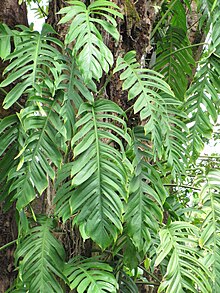| Epipremnum | |
|---|---|

| |
| Epipremnum pinnatum | |
| Scientific classification | |
| Kingdom: | Plantae |
| Clade: | Tracheophytes |
| Clade: | Angiosperms |
| Clade: | Monocots |
| Order: | Alismatales |
| Family: | Araceae |
| Subfamily: | Monsteroideae |
| Tribe: | Monstereae |
| Genus: | Epipremnum Schott |
| Synonyms[1] | |
|
Anthelia Schott 1863, illegitimate homonym, not Dumort. 1835 | |
Epipremnum is a genus of flowering plants in the family Araceae, found in tropical forests from China, the Himalayas, and Southeast Asia to Australia the western Pacific.[1][2][3] They are evergreen perennial vines climbing with the aid of aerial roots.[4] They may be confused with other Monstereae such as Rhaphidophora, Scindapsus and Amydrium.
All parts of the plants are toxic, mostly due to trichosclereids (long sharp cells) and raphides. Plants can grow to over 40 m (131 ft) with leaves up to 3 m (10 ft) long, but in containers the size is much reduced. The plants, commonly known as centipede tongavine, pothos or devil's ivy, depending on species, are typically grown as houseplants in temperate regions. Juvenile leaves are bright green, often with irregularly variegated patterns of yellow or white. They may find host trees by the use of skototropism.[5]


- ^ a b Kew World Checklist of Selected Plant Families
- ^ Govaerts, R. & Frodin, D.G. (2002). World Checklist and Bibliography of Araceae (and Acoraceae): 1-560. The Board of Trustees of the Royal Botanic Gardens, Kew.
- ^ Flora of China Vol. 23 Page 14, 麒麟叶属 qi lin ye shu, Epipremnum Schott, Bonplandia (Hannover). 5: 45. 1857.
- ^ RHS A-Z encyclopedia of garden plants. United Kingdom: Dorling Kindersley. 2008. p. 1136. ISBN 978-1405332965.
- ^ Strong & Ray 1975.